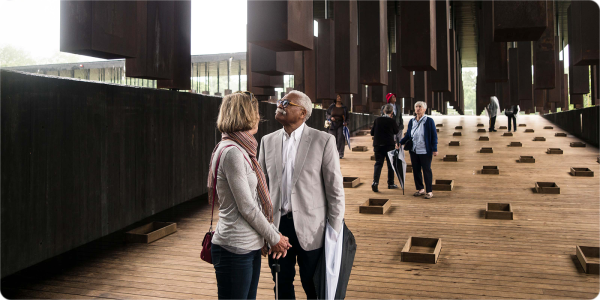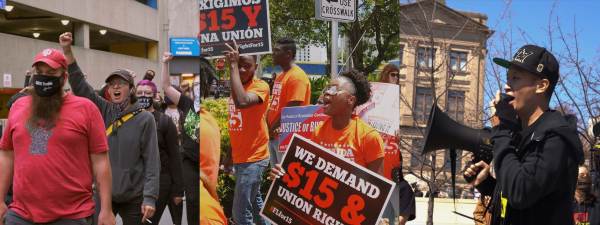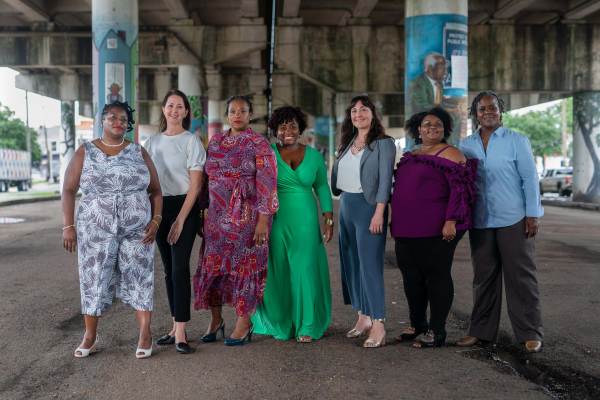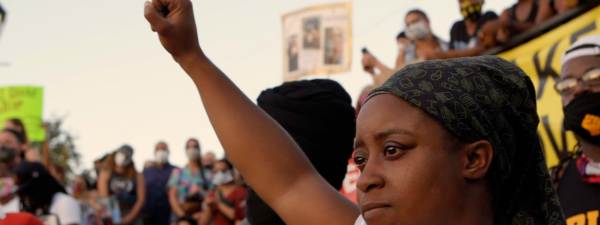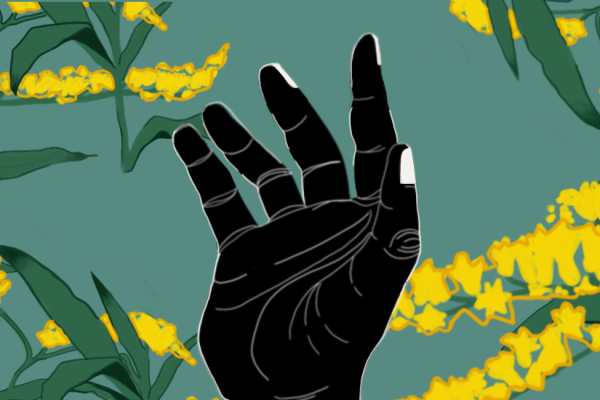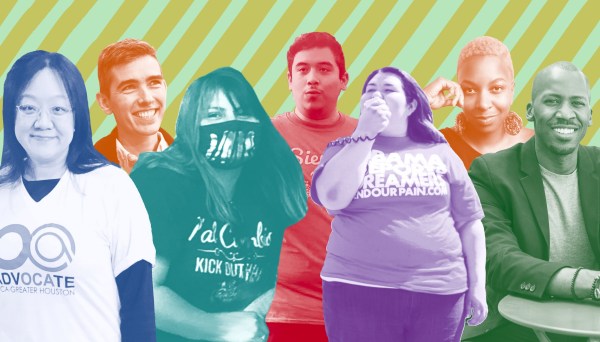The Story of the South is the Story of America

Transcript
[Footage and images support the narrative throughout. A fast-paced montage of footage from the American South. An arch truss bridge rises from Appalachian Mountain forest, spans high above West Virginia’s New River gorge. On Nashville’s Music Row, neon-lit signs hang above music venues. Protesters topple a Confederate soldier statue from its pedestal, and it lands on its head while by standers cheer.]
VOICE-OVER: The American South:13 states in the Southeast, stretching from Virginia to Texas.
ACTIVIST [wearing a Black Lives Matter T-shirt, speaking through a megaphone]: Who feels that?
[celebratory big band music]
[Black-and-white archival footage from the 1920s through the 60s. Black couples wing dance as spectators look on. Martin Luther King Jr. marching from Selma. Black sharecroppers work in a cotton field. Close-up of the opening lines of the US Constitution.]
VOICE-OVER: A region with a shared social, economic, and political history that has greatly influenced the trajectory of the country since the United States was born. And today is no exception.
ACTIVIST: We must love each other and protect each other!
[Present-day marches and protests. Signs include “Still we rise” and “Keep Trans Women Safe.” The statue of Robert E. Lee in New Orleans is removed from its pedestal by a crane.]
VOICE-OVER: Today, the South is in the midst of a historic transformation …
ACTIVIST: Live in healthy communities!
VOICE-OVER: …that will have a profound impact on the entire country—and on our collective future. Here’s why.
The South Is Powerful.
[A map of the United States appears, and the southeast portion gradually fills in with the abbreviations for 13 states: Texas, Arkansas, Louisiana, Mississippi, Alabama, Florida, Tennessee, Georgia, Kentucky, North Carolina, South Carolina, Virginia, West Virginia.]
The South is the fastest-growing region in the USA quarter of America’s population growth over the last 10 years has been in these 13 states. And with this growth comes rising political clout. Right now, the South is home to one-third of all Electoral College votes, which determine who becomes president. After the 2020 census, the region was allocated an additional three congressional votes. This means the South has growing potential to influence the priorities of the whole country.
The South Is Diverse and Dynamic.
The South is white urban and rural communities. And it is home to the Black Belt, a stretch of counties with large African American populations, both urban and rural. Today, half of all African Americans in the US live in the 13 Southern states. And return migration is bringing more and more African Americans back to the South. But it’s not just Black and white. The Latinx population grew faster in the South than in any other US region since 2010. And in the last decade, Texas, Florida, and Virginia have seen the fastest-growing Asian and Asian American populations.
[Footage of people of different races and ages together. Graphics of headlines animate over the footage. The New York Times: “We’re Here, We’re Queer, Y’all.”
Forbes: “The Changing Geography of Asian America: To the South and the Suburbs.” The Los Angeles Times: “New Latino South.”]
VOICE-OVER: And gay, lesbian, and transgender people are building their futures in the South’s big cities and its small towns. Throughout these communities, the South is home to innovators, artists, and activists …
VIRGINIA DELEGATE DANICA ROEM[rousing a crowd at a rally, with a sign that reads, “Virginia is for lovers of equality.”]:Let’s change the world y’all!
[crowd cheers]
VOICE-OVER:… with a deep love for the region, and the drive and passion to make it thrive.
The South Is an Incubator.
Many of our country’s most regressive policies were, and are, forged and tested in the South.
[Black-and-white footage of a young Black boy drinking from a water fountain labeled “colored.” In a present-day scene, a crowd fills North Carolina’s State House to protest a bill restricting transgender people’s access to public restrooms. Graphics of headlines animate over the footage. The New York Times: “North Carolina Strikes a Deal to Repeal Restrictive Bathroom Bill.” Outside the South Carolina State House, activist Bree Newsome climbs the flagpole to remove a Confederate flag.
BREE NEWSOME: In the name of Jesus, this flag has to come down!
VOICE-OVER: But the South and its diverse culture has also been a springboard for visionary thinking.
FORMER TEXAS STATE SENATOR WENDY DAVIS [addressing news crews at a Texas Organizing Project event]: Even in the hard times, we become who our voices ultimately are.
VOICE-OVER: It’s the birthplace of movements that have transformed the country.
LARGE CROWD [chanting at a Confederate flag protest] :Take it down! Take it down! Take it down!
VOICE-OVER: The South Is Ready.
Today, the South is entering what could be described as a Third Reconstruction. The First Reconstruction launched a record number of African American officials into public office, pioneering policies for expanding public education, labor rights, and democratic access. The civil rights movement—a Second Reconstruction—ended Jim Crow laws, and sparked liberation movements across the South and the whole country. And today, some of the most innovative social justice campaigns in the country…
ACTIVIST [swinging her hips and firing up the crowd at a Black and Trans Lives Matter march]: Down with police violence!
VOICE-OVER: … are conceived and led by local organizers in the South. Communities in the region are also promoting a transition from dependence on polluting power sources to an economy fueled by clean energy.
ACTIVIST [addressing a crowd]:We want a just transition, one that is equitable to all.
VOICE-OVER: These are some examples. There are countless others.
ACTIVISTS [chanting at a farmworkers’ march]: Hey hey! Ho ho! Exploitation has got to go!
VOICE-OVER: This is the South today.
REVEREND DR. WILLIAM J. BARBER [addressing a crowd]:Let the world see some Black and white folk hugging each other.
VOICE-OVER: A region of immense promise and potential that, with the right investments, could drive a period of profound change for the entire country. Now is the time to realize the true promise of this vibrant and powerful region.
[on-screen graphic: The Institute for Southern Studies in collaboration with the Ford Foundation. On-screen graphic: Ford Foundation logo. Full credits appear in the transcript.]
Accessibility Statement
- All videos produced by the Ford Foundation since 2020 include captions and downloadable transcripts. For videos where visuals require additional understanding, we offer audio-described versions.
- We are continuing to make videos produced prior to 2020 accessible.
- Videos from third-party sources (those not produced by the Ford Foundation) may not have captions, accessible transcripts, or audio descriptions.
- To improve accessibility beyond our site, we’ve created a free video accessibility WordPress plug-in.
The South is the fastest-growing region in the United States, and it’s remarkably diverse. Half of all Black Americans live in its 13 states and, with expanding Latinx and AAPI populations, increasing LGBTQ+ visibility, and a mix of rural and urban communities, the South is rapidly becoming a region rich with culture—and opportunity.
From Texas to Mississippi to Virginia, the South has long been an incubator for social change. And its legacy of abolition, reconstruction and desegregation is alive today—in movements to realize the country’s highest ideals of freedom and equality. Advocates and organizations across the South are at the forefront of many of America’s fights for civil rights, from reproductive justice and voting rights to transgender equality and workers’ rights.
Today, southerners from every walk of life are joining forces to usher in a Third Reconstruction, showing America what’s possible when it confronts its history, reconciles with its differences, and reimagines a more perfect, more just union together.
